I picked up this box of stone ground white cornmeal at Kenyon's grist mill in Usquepaug, RI last Saturday. I used it to make a Savory Jalapeno Cornbread tonight, using a recipe I got from my friend Ann Daigle, who lives in New Orleans and hates the sweet cornbread that we Yankees too often eat up here. Her recipe called for a mix of white wheat flour and yellow cornmeal, I think because it's hard to get the real stone ground white cornmeal that was traditionally used in the south for savory cornbread (yellow cornmeal is sweeter than white cornmeal). Since I could get white cornmeal, I just used cornmeal. At the suggestion of my daughter-in-law April Bauza I also added chopped, seeded fresh jalapeno peppers to the recipe.
You make it with cornmeal, baking powder, baking soda, egg and buttermilk, to which you add some melted bacon fat and bake it in a cast iron skillet.
Here's what the finished product looks like:

[Actually, on reflection and with feedback from Linda Buchanan, this was too dry, as I think the white cornmeal cooks differently than the yellow cornmeal/white flour mix in the original recipe. So I cooked another batch just now (Tuesday) and reduced the cooking time from 25 to 20 minutes, increased the buttermilk from 1 1/4 cups to 1 1/2 cups and increased the bacon fat from 3 T to 4 T.]
This is what it should look like:
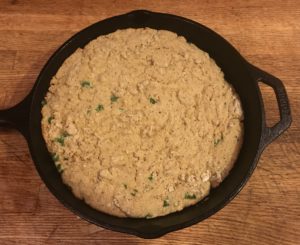
My favorite way to eat this cornbread is to cut a wedge of it, slice the wedge through the middle and put it in the bottom of a bowl, like this:
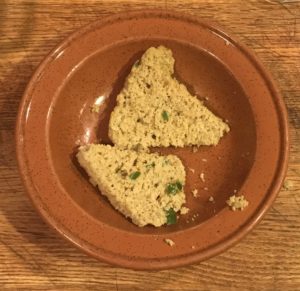
And then pour some chili over it:

The cornbread gives an earthy base to the chili that I really like. It absorbs some of the chili and softens, taking on a taste and texture like the masa wrapper of a tamale. To me, these two foods, chili and savory cornbread, were made to go with each other.
With this in mind, earlier this week I decided to attempt to climb up the Mt. Everest of chili: the "Best Chili" recipe in the Food Lab cookbook. This is a crazy, over-the-top recipe, which involves chopping up your own meat, making your own chili paste from a mix of dried peppers, toasting and grinding whole spices, and using a host of umami-enhancing ingredients (anchovies, Marmite, soy sauce).
Here is a picture of all the ingedients involved (including the garnishes):
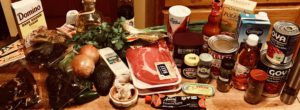
I wish I could say that the first chili I made from all these ingredients was the best chili I ever had. Alas, it was not. It might be that I used chuck instead of the short ribs that were called for, or that I didn't brown the meat quite enough before I ground it, or that I only could find two of the three types of dried chilis for the chili paste. But I also think it was because the Food Lab recipe calls for a 28-ounce can of crushed tomatoes, on top of 2 T of tomato paste. This is too much tomato. It makes the chili too tomatoey and too sweet, drowning out the flavor of the meat and the chiles. In my second attempt, I substituted some fresh, end-of-the-season tomatoes I got at today's OS farmers market for the canned crushed tomatoes.
I bought some bone-in beef short ribs at Walt's this morning, and found the missing peppers at the Latino grocery store in New London this afternoon on my way back from Kenyon's again, as they are having an open house with tours of the grist mill this weekend (see photos below). Also bought some dried black beans to make from scratch, instead of canned, and in place of the red kidney beans called for in the Food Lab recipe. Also got what I need to make my own chicken stock from scratch. So now I'm ready to make a second attempt on the Food Lab chili.
Savory Jalapeno Cornbread recipe follows Kenyon's pictures. Notes on the second, successful, attempt on the Food Lab chili follow that, along with the chili recipe.
Open House at Kenyon's
The mill pond at Kenyon's:
The mill dam:

The grist mill:
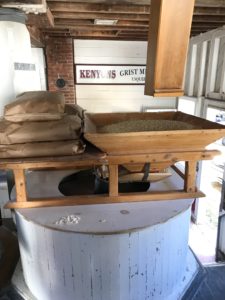
The "White Dent" corn used to make Kenyon's white cornmeal, raised by a farm in Virginia:
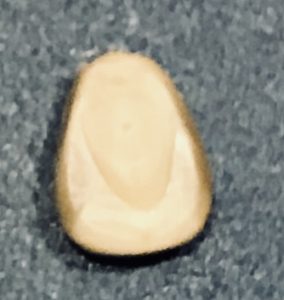
Savory Jalapeno Cornbread
INGREDIENTS:
2 cups stone ground white cornmeal
1 tsp baking soda
1 tsp baking powder
1 tsp kosher salt
1 egg
1 1/2 cups buttermilk
2 jalapeno peppers, seeded and chopped
3-4 T bacon fat
DIRECTIONS:
Preheat oven to 375F.
Gently mix the cornmeal, baking soda, baking powder and salt. Whisk together egg and buttermilk, then add to the dry ingredients. Melt 3-4 T of bacon grease in a cast iron skillet, swish around pan to coat all sides, then pour into the batter, mix, then pour batter into the hot skillet. Put the skillet in the preheated oven, and bake 20 minutes till just starting to brown on top. Don't over cook it, or it will be too dry. As my friend Linda Buchanan says, "Think of it as if you are baking a brownie; you want it to be just cooked inside." Linda's Southern grandmother made a savory cornbread every day, so she knows what she's talking about. I have been using a 10-inch skillet for this recipe, which may cook it too fast. At Linda's suggestion, I plan to get an 8-inch skillet which will result in a higher cornbread that cooks more slowly.
Making the Chili
Making the Food Lab's "Best Short Rib Chili" involved five distinct steps: making the chicken stock, making the beans, making the chile paste, browning and chopping the meat, and then using these and other ingredients to make the chili itself. I will do a separate blog on the chicken stock. The beans just involve soaking the beans overnight in salted water and then simmering them for 45 minutes the next day and seasoning to taste. I used black beans rather than the red kidney beans called for in the Food Lab recipe because I like them better. Otherwise, nothing special about making the beans, so I'll focus on the chile paste, the meat and the chili itself.
The Chile Paste
Here are the three types of chiles that I used to make the chili paste, which the Food Lab recipe calls for in lieu of chile powder:
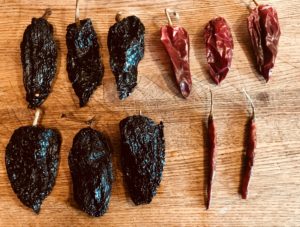
The six dark chiles are what Food Lab calls "rich and fruity" type chiles. The three on the top are anchos and the three on the bottom are mulattos. They have an aroma like prunes or sun dried tomatoes. The three red chiles on the top right are what Food Lab calls "sweet and fresh" type chiles. The ones pictured are costenos. These chiles have an earthy aroma like roasted red bell peppers. The small red chiles on the bottom right are what Food Lab calls "hot" type chiles. The ones pictured are arbol. Overwhelming heat and not much else. The Food Lab recipe calls for six ""rich and fruity" chiles, three "sweet and fresh" chiles, and two "hot" chiles. In addition to the above, I added a New Mexico "sweet and fresh" chile that I had left over from my first attempt, because the three costenos were a little small. In my first attempt, I didn't have the arbols, and as a consequence, the chile paste and the chili weren't spicy enough.
Here are the chiles seeded and torn into small pieces for toasting:
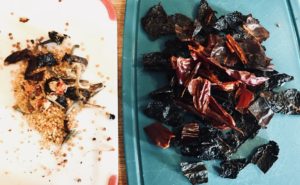
Here are the chiles being toasted in a Dutch oven. After you toast them, you add chicken stock and simmer them until soft and then make them into a paste in a food processor.
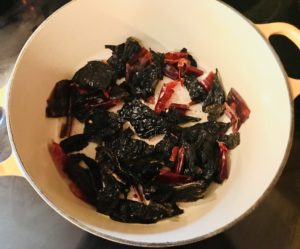
The Meat
Here are the short ribs after seasoning with salt and pepper:

Here is a batch browning in the Dutch oven:
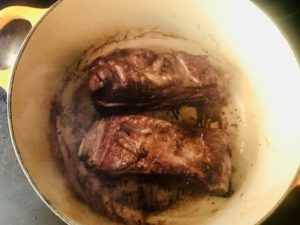
And here are the finished browned short ribs:

Making the Chili
You start by making a "sofrito" of onion, garlic, fresh jalapeno and dried oregano in the fat left over from browning the short ribs. This was probably the key missing step in my first attempt, as the chuck I used instead of the short ribs didn't have enough fat. When making any kind of beans it is essential in my mind to saute the sofrito in animal fat. Normally I use bacon fat. No need to do that here as there was plenty of fat from browning the short ribs. Here is the sofrito--the onions are not dark from browning, but rather from the brown bits in the pan after browning the short ribs:
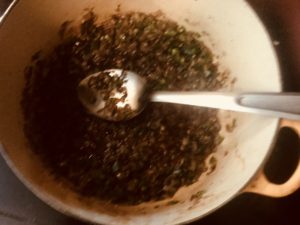
You then add the chile paste and chicken stock, toasted and ground cumin and coriander seeds, unsweetened cocoa, cornmeal and then these three Food Lab umami ingredients, soy sauce, anchovy and Marmite:
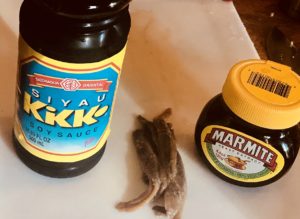
Then you slice the meat off the bones, and chop it into small pieces like this (the first time I chopped/ground the browned meat in a food processor; this time I chopped by hand, which I think resulted in better sized chunks--btw, this is just the meat from one of the five ribs):
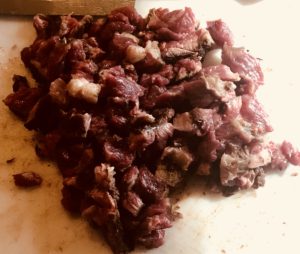
You add the meat and bones and some bay leaves to the chili and cook in a 225F oven for an hour.
Then you add the beans, vinegar and tomatoes. I used five medium fresh tomatoes rather than the 28-ounce can of crushed tomatoes, but sauteed them first to soften them:
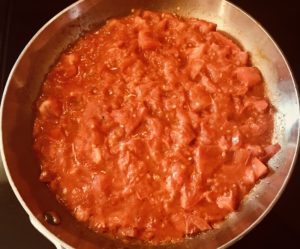
You then cook the chili in a 225F oven for another two hours, and then finish it with some tequila (or bourbon), hot sauce and brown sugar. Here is the finished chili in a bowl over cornbread, garnished with some avocado, a mix of Mexican cheeses, scallions, chopped cilantro and some more hot sauce:
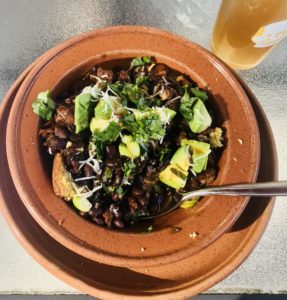
And here are my two tasters, Dave and Gary Steuber:
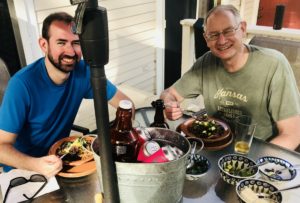
It must have been good. They asked for a second bowl.
A Note About Food Lab
The Food Lab: Better Home Cooking Through Science by J. Kenji Lopez-Alt, is one of my two favorite cookbooks (the other being Jerusalem). Everything I've cooked from it has been amazing. The author is a self-proclaimed food geek, and did a stint as the head of the food lab at Cook's Magazine before going out on his own. He not only explains what to do, but also why. That's important to me, as I too am a food geek, and subscribed to Cook's during the period that J. Kenji Lopez-Alt was running the science. I highly recommend the book. Go buy it now. The recipe which follows is almost directly from the book. I changed the beans from red kidney to black, but you can use whatever beans you like in your chili. I made mine from dried beans, but canned work fine. I used fresh tomatoes rather than the canned tomatoes in the original recipe, but canned are fine. Don't substitute chuck for the short ribs as I did in my first attempt. The short ribs have much more flavor, especially the bone-in ones, and render a good deal of fat, which helps with browning and serves as an essential medium to make the "sofrito"--the onion, jalapeno, garlic and oregano base that is the starter for the chili. I think my chopped-by-hand meat in my second attempt came out better than my food processor chopped/ground meat in my first attempt, but you could go with the food processor, especially if you want some very small bits of meat. The meat is salted before browning, the beans are salted during soaking and cooking, and the umami ingredients are all salty, but there is no other added salt for the chili. Taste it at the end and adjust seasoning as necessary.
Best Short Rib Chili
For the chile paste:
Makes about 2 cups
INGREDIENTS:
6 ancho, pasilla or mulato chiles (about 1/4 ounce) seeded and torn into rough 1-inch pieces
3 New Mexico red, California, costeno or choricero chiles (about 1/8 ounce), seeded and torn into 1-inch pieces
2 coscabel, arbol or pequin chiles, seeded and torn in half
2 cups homemade or low-sodium canned chicken stock
DIRECTIONS:
Toast the dried chiles in a Dutch oven over medium-high heat, stirring frequently until slightly darkened, with an intense roasted aroma, 2 to 5 minutes, turn down the heat if they begin to smoke. Add the chicken stock and simmer until the chiles have softened, 5 to 8 minutes. Transfer the chiles and liquid to a blender and blend, starting on low speed and gradually increasing the speed to high and scraping down the sides as necessary, until a completely smooth puree is formed, about 2 minutes; add water as necessary if too thick to blend.
For the chili:
INGREDIENTS:
5 pounds bone-in beef short ribs. trimmed of silverskin and excess fat (I could have trimmed mine a bit more)
Kosher salt and freshly ground black pepper
2 T vegetable oil
1 large yellow onion, finely diced (about 1 1/2 cups)
1 jalapeno or 2 serano chiles, finely chopped
4 medium cloves garlic, minced or grated on a microplane (about 4 tsp)
1 T dried oregano
1 cup chile paste (about half of the recipe above)
4 cups homemade or low sodium canned chicken stock
4 anchovy fillets, mashed into a paste with two forks
1 tsp Marmite
1 T soy sauce
2 T tomato sauce
2 T cumin seeds, toasted and ground
2 tsp coriander seeds, toasted and ground
1 T unsweetened cocoa powder
2-3 T instant cormeal (such as Maseca)
2 bay leaves
1 pound dried black beans (or other beans) soaked in salted water overnight at room temperature, and drained
5 medium fresh tomatoes, chopped and sauteed till soft
1/4 cup cider vinegar or more to taste
1/4 cup tequila or bourbon
2 T Frank's RedHot or other hot sauce
2 T dark brown sugar
Sea salt to taste
Garnishes such as chopped avocado, chopped cilantro, grated cheddar cheese. sliced jalapenos, chopped onions, sliced scallions or sour cream.
DIRECTIONS:
Season the short ribs on all sides with salt and pepper. Heat the oil in a large Dutch oven until smoking. Add half of the short ribs and brown well on all sides (it may be necessary to brown the short ribs in three batches depending on the size of the Dutch oven--do not over crowd), 8-12 minutes per batch; reduce the heat if the fat begins to smoke excessively or the meat begins to burn. Transfer to a large platter. Repeat with the remaining short ribs, browning them in the fat remaining in the Dutch oven.
Reduce the heat to medium, add the onion, and cook, scraping up the browned bits from the bottom of the pan with a wooden spoon and stirring frequently, until softened but not browned, 6 to 8 minutes. Add the fresh chiles, garlic and oregano and cook, stirring, until fragrant, about 1 minute. Add the chile paste and cook, stirring and scraping constantly, until it leaves a coating on the bottom of the pot, 2 to 4 minutes. Add the chicken stock and scrape up the browned bits from the bottom of the pot. Add the anchovies, Marmite, soy sauce, tomato paste, ground spices, cocoa and cornmeal and whisk to combine. Keep warm over low heat.
Adjust oven rack to lower-middle position and preheat the oven to 225F. Remove the meat from the bones, and reserve the bones. Chop all of the meat into rough 1/4 inch to 1/2 inch pieces (or finer if your prefer). Add any accumulated juices from the cuting board to the Dutch oven, then add the chopped beef, beef bones and bay leaves and bring to a simmer. Cover and place in the oven for 1 hour.
Meanwhile, transfer the drained beans to a pot and cover with water by 1 inch. Season to taste with salt. Bring to boil over high heat, then reduce to a simmer and cook until the beans are nearly tender, about 45 minutes. Drain.
Remove the chili from the oven and add the tomatoes, vinegar and beans. Return to the oven with the lid slightly ajar and cook until the beans and the meat are tender and the stock is rich and slightly thickened, 1 1/2 to 2 hours longer; add water if necessary to keep the meat and beans submerged ( a little protrusion is OK).
Using tongs, remove the bay leaves and bones (any meat still attached to the bones can be removed, chopped and added to the chili if desired, but avoid adding any tough pieces). Add the tequila or bourbon, hot sauce and brown sugar and stir to combine. Season to taste with salt, pepper and/or vinegar.
Serve, or for the best flavor, allow the chili to cool and refridgerate overnight, then reheat. The chili is best served over a sliced wedge of the Savory Jalapeno Cornbread and topped with some or all of the garnishes.
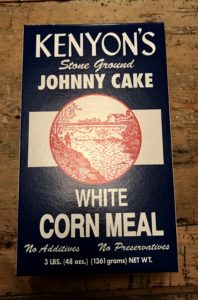

OMG–there’s MARMITE in that recipe! After all your years of mocking me for my love of Marmite, you’ve actually had to consume it (albeit in what sounds and looks like an incredibly more-ish chilli over cornbread dish). HAHAHAHAHA
Ah, yes. But so much better as a food additive than as a jam.